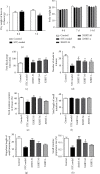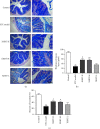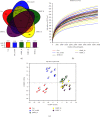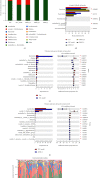Xuanhuang Runtong Tablets Relieve Slow Transit Constipation in Mice by Regulating TLR5/IL-17A Signaling Mediated by Gut Microbes
- PMID: 36700038
- PMCID: PMC9870700
- DOI: 10.1155/2023/6506244
Xuanhuang Runtong Tablets Relieve Slow Transit Constipation in Mice by Regulating TLR5/IL-17A Signaling Mediated by Gut Microbes
Abstract
This study aims to investigate the regulation effects of Xuanhuang Runtong tablets (XHRTs) on intestinal microbes and inflammatory signal toll receptor 5 (TLR5)/interleukin-17A (IL-17A) in STC mice. First, high-performance liquid chromatography (HPLC) was used to verify the composition of XHRT and quality control. Then, the defecation ability of STC mice was evaluated by measuring fecal water content and intestinal transit function. The pathological examination of colonic mucosa was observed by Alcian Blue and periodic acid Schiff (AB-PAS) staining. 16S ribosomal DNA (16S rDNA) genes were sequenced to detect the fecal microbiota. Western blotting, immunofluorescence, and real-time fluorescence quantitative PCR (qRT-PCR) were applied to detect the expression of aquaporin 3 (AQP3), connexin 43 (Cx43), TLR5, and IL-17A. The defecation function of the STC mice was significantly decreased. The amount of mucus secretion and the thickness of the colonic mucus layer were decreased, and the number of microbial species in the intestinal wall, such as Firmicutes/Bacteroidetes, anaerobic bacteria, and Alistipes, were also decreased. In addition, the expression of AQP3 and Cx43 was disordered, and the inflammatory factorsTLR5 and IL-17A were activated in the colon. The changes in the above indicators were significantly reversed by XHRT. This study demonstrates that XHRT provides a new strategy for the treatment of slow transit constipation by regulating the activation of the intestinal inflammatory signal TLR5/IL-17A mediated by gut microbes.
Copyright © 2023 Xuejuan Liang et al.
Conflict of interest statement
The authors declare that they have no conflicts of interest.
Figures








Similar articles
-
Effects of Maren Pills on the Intestinal Microflora and Short-Chain Fatty Acid Profile in Drug-Induced Slow Transit Constipation Model Rats.Front Pharmacol. 2022 Apr 12;13:804723. doi: 10.3389/fphar.2022.804723. eCollection 2022. Front Pharmacol. 2022. PMID: 35496291 Free PMC article.
-
Poly-γ-glutamic acid alleviates slow transit constipation by regulating aquaporin and gut microbes.Sci Rep. 2025 Mar 10;15(1):8244. doi: 10.1038/s41598-025-92783-2. Sci Rep. 2025. PMID: 40065004 Free PMC article.
-
Cinnamic acid regulates the intestinal microbiome and short-chain fatty acids to treat slow transit constipation.World J Gastrointest Pharmacol Ther. 2023 Mar 5;14(2):4-21. doi: 10.4292/wjgpt.v14.i2.4. World J Gastrointest Pharmacol Ther. 2023. PMID: 36911598 Free PMC article.
-
Effects of sEA on Slow Transit Constipation through the Microbiota-Gut-Brain Axis in Rats.Evid Based Complement Alternat Med. 2020 Dec 14;2020:8828846. doi: 10.1155/2020/8828846. eCollection 2020. Evid Based Complement Alternat Med. 2020. PMID: 33414840 Free PMC article.
-
The Fecal Microbiota Transplantation: A Remarkable Clinical Therapy for Slow Transit Constipation in Future.Front Cell Infect Microbiol. 2021 Oct 22;11:732474. doi: 10.3389/fcimb.2021.732474. eCollection 2021. Front Cell Infect Microbiol. 2021. PMID: 34746023 Free PMC article. Review.
Cited by
-
Roles and regulation of Aquaporin-3 in maintaining the gut health: an updated review.Front Physiol. 2023 Nov 28;14:1264570. doi: 10.3389/fphys.2023.1264570. eCollection 2023. Front Physiol. 2023. PMID: 38089478 Free PMC article. Review.
-
Olive Oil Solution of Volatile Oil from Citri Reticulatae Pericarpium Viride Alleviates Slow-Transit Constipation via Regulating SCF/c-Kit Signaling Pathway and Intestinal Flora.Drug Des Devel Ther. 2025 May 22;19:4275-4295. doi: 10.2147/DDDT.S517114. eCollection 2025. Drug Des Devel Ther. 2025. PMID: 40433571 Free PMC article.
-
Qi Lang formula relieves constipation via targeting SCF/c-kit signaling pathway: An integrated study of network pharmacology and experimental validation.Heliyon. 2024 May 23;10(11):e31860. doi: 10.1016/j.heliyon.2024.e31860. eCollection 2024 Jun 15. Heliyon. 2024. PMID: 38841509 Free PMC article.
References
LinkOut - more resources
Full Text Sources

